1993 PONTIAC GRAND-AM brake
[x] Cancel search: brakePage 127 of 306
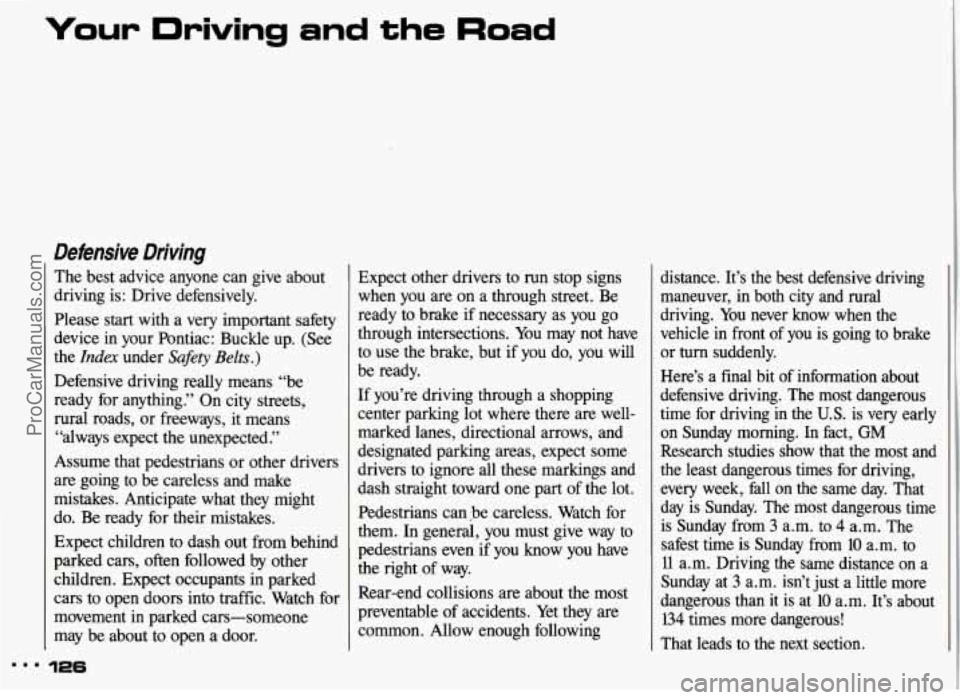
Defensive Driving
The best advice anyone can give about
driving is: Drive defensively.
Please start with a very important safety
device in your Pontiac: Buckle up. (See
the
Index under Safety Belts.)
Defensive driving really means “be
ready for anything.” On city streets,
rural roads, or freeways, it means
“always expect the unexpected
.”
Assume that pedestrians or other drivers
are going to be careless and make
mistakes. Anticipate what they might
do. Be ready for their mistakes.
Expect children to dash out from behind
parked cars, often followed
by other
children. Expect occupants in parked
cars to open doors into traffic. Watch for
movement in parked cars-someone
may be about to open a door.
126
Expect other drivers to run stop signs
when you are on a through street. Be
ready to brake if necessary as you go
through intersections. You may not have
to use the brake, but if you do, you will
be ready.
If you’re driving through a shopping
center parking lot where there are well-
marked lanes, directional arrows, and
designated parking areas, expect some
drivers to ignore all these markings and
dash straight toward one part of the lot.
Pedestrians canbe careless. Watch for
them.
In general, you must give way to
pedestrians even if you know you have
the right of way.
Rear-end collisions are about the most
preventable of accidents. Yet they are
common. Allow enough following distance. It’s the best defensive driving
maneuver, in both city and rural
driving. You never know when the
vehicle in front
of you is going to brake
or
turn suddenly.
Here’s a final bit of information about
defensive driving. The most dangerous
time for driving in the
U.S. is very early
on Sunday morning. In fact, GM
Research studies show that the most and
the least dangerous times for driving,
every week, fall on the same day. That
day is Sunday. The most dangerous time is Sunday from
3 a.m. to 4 a.m. The
safest time is Sunday from
10 a.m. to
11 a.m. Driving the same distance on a
Sunday at
3 a.m. isn’t just a little more
dangerous than it is at
10 a.m. It’s about
134 times more dangerous!
That leads to the next section.
ProCarManuals.com
Page 130 of 306
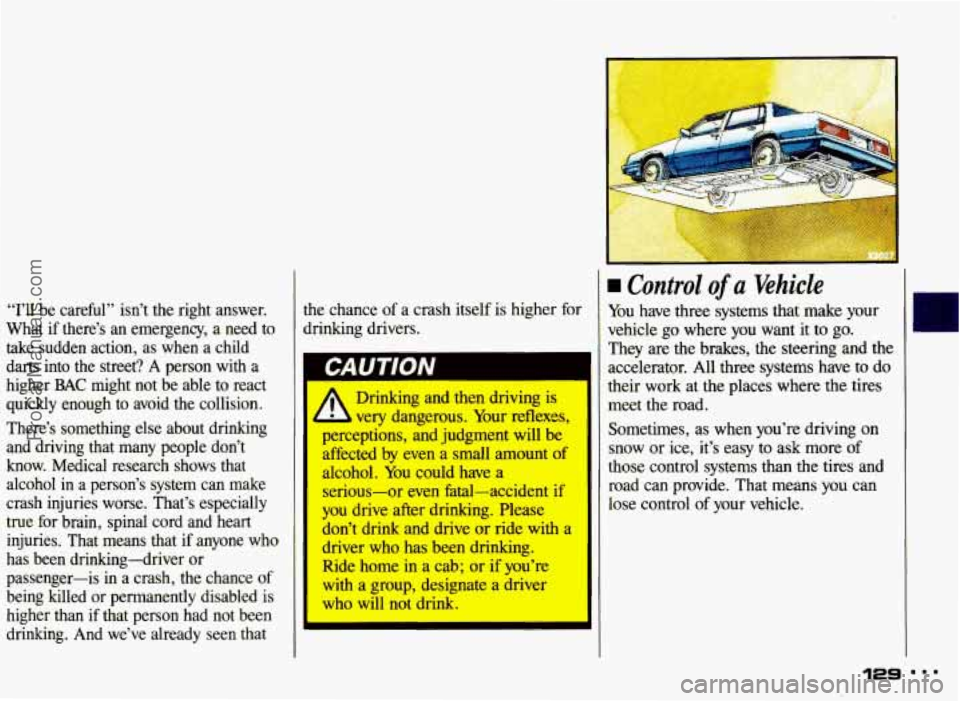
“I’ll be careful” isn’t the right answer.
What if there’s an emergency, a need to take sudden action, as when a child
darts into the street?
A person with a
higher
BAC might not be able to react
quickly enough to avoid the collision.
There’s something else about drinking
and driving that many people don’t
know. Medical research shows that
alcohol in a person’s system can make
crash injuries worse. That’s especially
true for brain, spinal cord and heart
injuries. That means that if anyone who
has been drinking-driver or
passenger-is in a crash, the chance of
being killed or permanently disabled is
higher than
if that person had not been
drinking. And we’ve already seen that the
chance of a crash itself is higher for
drinking drivers.
I
i Drinking and then driving is L b very dangerous. Your reflexes,
perceptions, and judgment will be
affected by even a small amount
of
alcohol. You could have a
serious-or even fatal-accident if
you drive after drinking. Please
don’t drink and drive or ride with a
driver who has been drinking.
Ride home in a cab; or if you’re
with a group, designate a driver
who will not drink.
I
rn Control of a Vehicle
You have three systems that make your
vehicle
go where you want it to go.
They are the brakes, the steering and the
accelerator. All three systems
have to do
their work at the places where the tires
meet the road.
Sometimes, as when you’re driving on
snow or ice, it’s easy to ask more of
those control systems than the tires and
road can provide. That means
you can
lose control of your vehicle.
ProCarManuals.com
Page 131 of 306
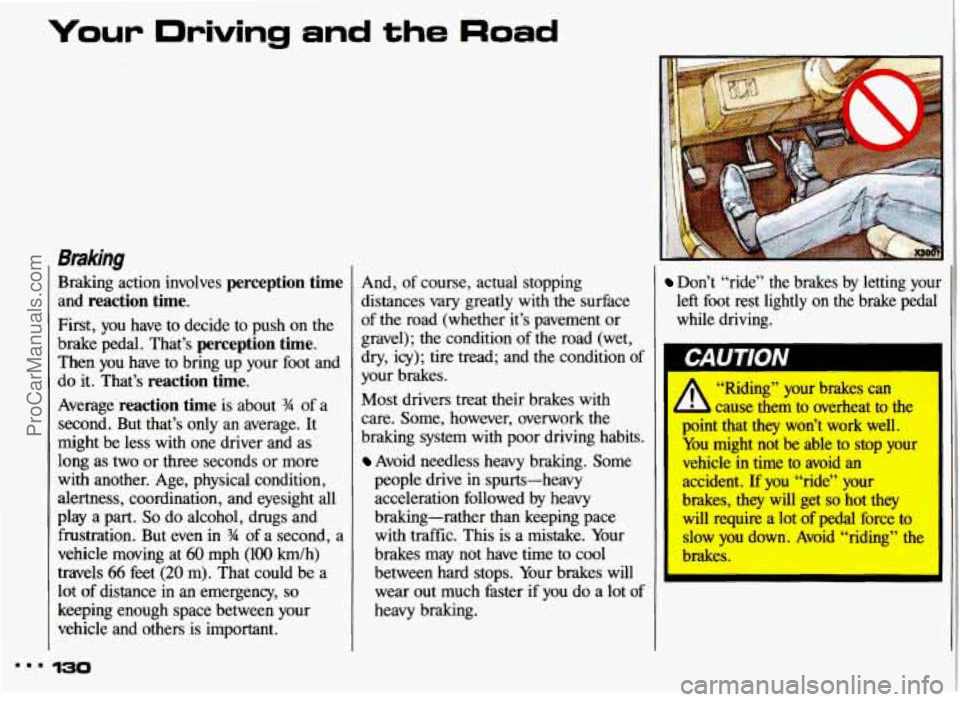
Your Driving and the Road
8mMng
Braking action involves perception time
and reaction time.
First, you have to decide to push on the
brake pedal. That’s perception time.
Then you have to bring up your foot and
do it. That’s reaction time.
Average reaction time is about 34 of a
second. But that’s only
an average. It
might be less with one driver and as
long as two or
three seconds or more
with another. Age, physical condition,
alertness, coordination,
and eyesight all
play a
part. So do alcohol, drugs and
frustration. But even in
34 of a second, a
vehicle moving at
60 mph (100 km/h)
travels
66 feet (20 m). That could be a
lot of distance in
an emergency, so
keeping enough space between your
vehicle and others is important. And,
of course, actual stopping
distances vary greatly with the surface
of the road (whether it’s pavement or
gravel); the condition of the road (wet,
dry, icy); tire tread; and the condition of
your brakes.
Most drivers treat their brakes with
care. Some, however, overwork the
braking system with poor driving habits.
Avoid needless heavy braking. Some
people drive in spurts-heavy
acceleration followed by heavy
braking-rather than keeping
pace
with traffic. This is a mistake. Your
brakes may not have time to cool
between hard stops. Your brakes will
wear out much faster if you
do a lot of
heavy braking.
Don’t “ride” the brakes by letting your
left foot rest lightly on the brake
pedal
while driving.
“Riding” your brakes can
cause them to overheat to the
point that they won’t work well.
You might not be able to stop your
vehicle in time to avoid an
accident.
If you “ride” your
brakes, they will get
so hot they
will require a lot of pedal force to slow you down. Avoid “riding” the
I
I brakes.
m.. 130
ProCarManuals.com
Page 132 of 306
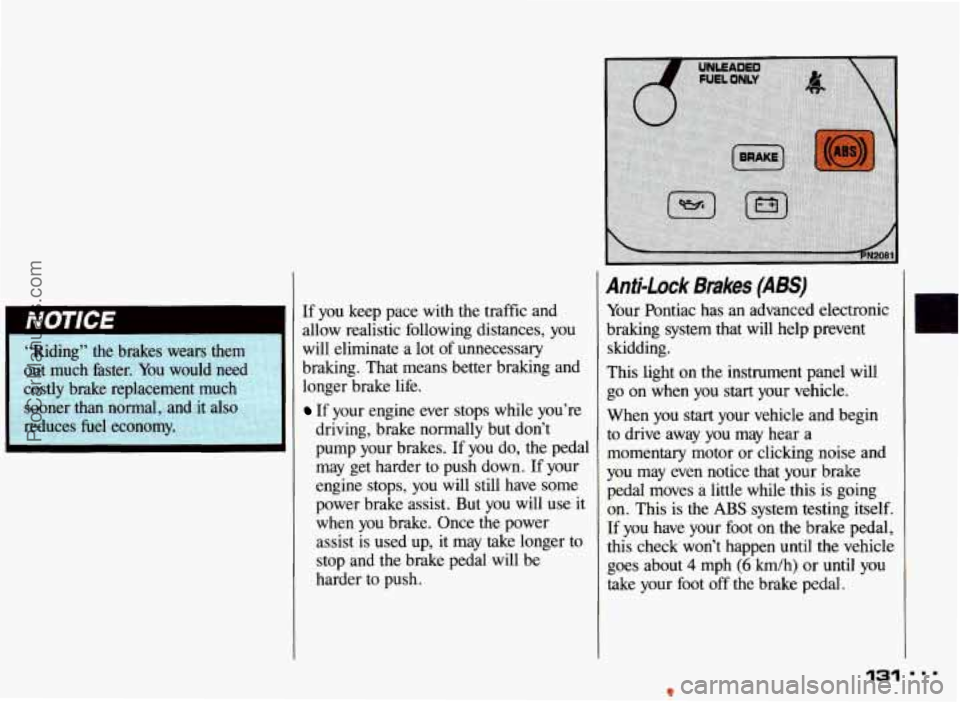
“Riding” the brakes wears them
out much faster. You would need
costly brake replacement
much
sooner than normal, and it also reduces fuel economy. If you keep pace with the traffic and
allow realistic following distances,
you
will eliminate a lot of unnecessary
braking. That means better braking and
longer brake life. If your engine ever stops while you’re
driving, brake normally but don’t
pump your brakes. If you do, the pedal
may get harder to push down. If your
engine stops, you will still have some
power brake assist. But
you will use it
when you brake. Once the power
assist is used up, it may take longer
to
stop and the brake pedal will be
harder to push.
Anti-Lock Bmkes (ABS)
Your Pontiac has an advanced electronic
braking system that will help prevent
skidding.
This light on the instrument panel will
go on when you start your vehicle.
When you
start your vehicle and begin
to drive away you may hear a
momentary motor or clicking noise
and
you may even notice that your brake
pedal moves a little while this is going
on. This is the ABS system testing itself.
If you have your foot on the brake
pedal,
this check won’t happen until the vehicle
goes about
4 mph (6 km/h) or until you
take your foot off the brake pedal.
131
ProCarManuals.com
Page 133 of 306
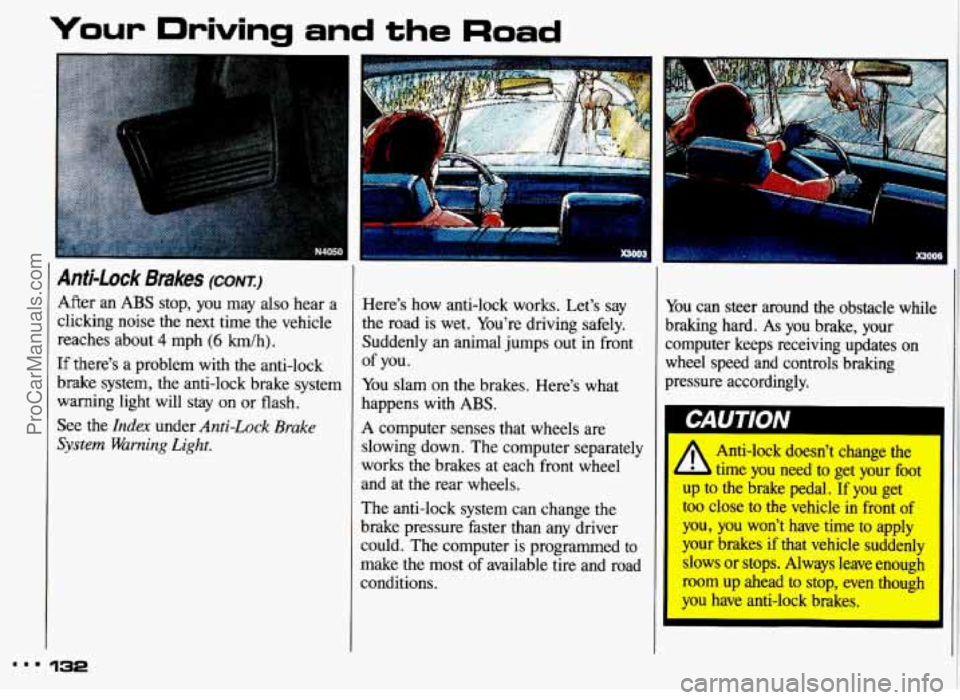
...
Your Driving and the Road
Anti-Lock Brakes (CONT.)
After an ABS stop, you may also hear a
clicking noise the next time the vehicle
reaches about
4 mph (6 km/h).
If there’s a problem with the anti-lock
brake system, the anti-lock brake system
warning light will stay
on or flash.
See the
Index under Anti-Lock Brake
System Warning Light.
132
Here’s how anti-lock works. Let’s say
the road is wet. You’re driving safely.
Suddenly an animal jumps out in front
You slam on the brakes. Here’s what
happens with ABS.
A computer senses that wheels are
slowing down. The computer separately
works the brakes at each front wheel
and at the rear wheels.
The anti-lock system can change the
of you.
brake pressure faster than any driver
could. The computer
is programmed to
make the most
of available tire and road
conditions. You
can steer around the obstacle while
braking hard.
As you brake, your
computer keeps receiving updates on
wheel speed and controls braking
pressure accordingly.
Anti-lock doesn’t change the
time you need
to get your foot
the brake pedal. If you get
too close to the vehicle in front
of
I you, you won’t have time to apply
your brakes
if that vehicle suddenly
slows or stops. Always leave enough
room up ahead to stop, even though
you have anti-lock brakes.
ProCarManuals.com
Page 134 of 306
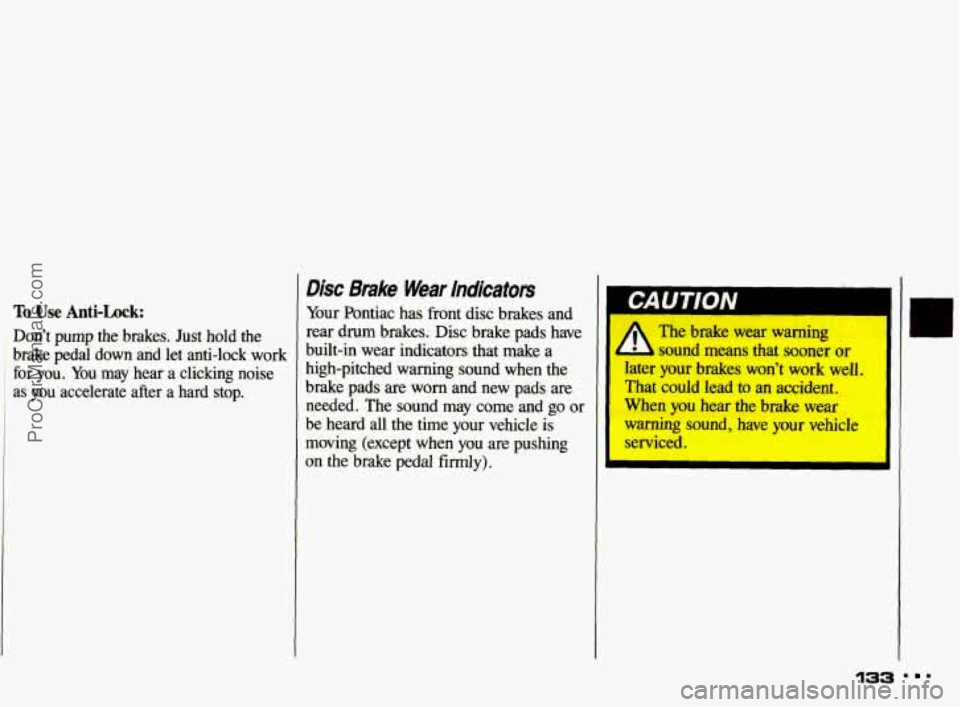
To Use Anti-Lock:
Don’t pump the brakes. Just hold the
brake pedal down and let anti-lock work
for
you. You may hear a clicking noise
as you accelerate after a hard stop.
Disc Brake Wear Indicators
Your Pontiac has front disc brakes and
rear drum brakes. Disc brake pads have
built-in wear indicators that make a
high-pitched warning sound when the
brake pads are worn and new pads are
needed. The sound may come and go or
be heard all the time your vehicle is
moving (except when you are pushing
on the brake pedal firmly).
A
The brake wear warning
sound means that sooner
or
later your brakes won’t work well.
That could lead to an accident.
When you hear the brake wear
warning sound, have your vehicle
serviced.
133
ProCarManuals.com
Page 135 of 306
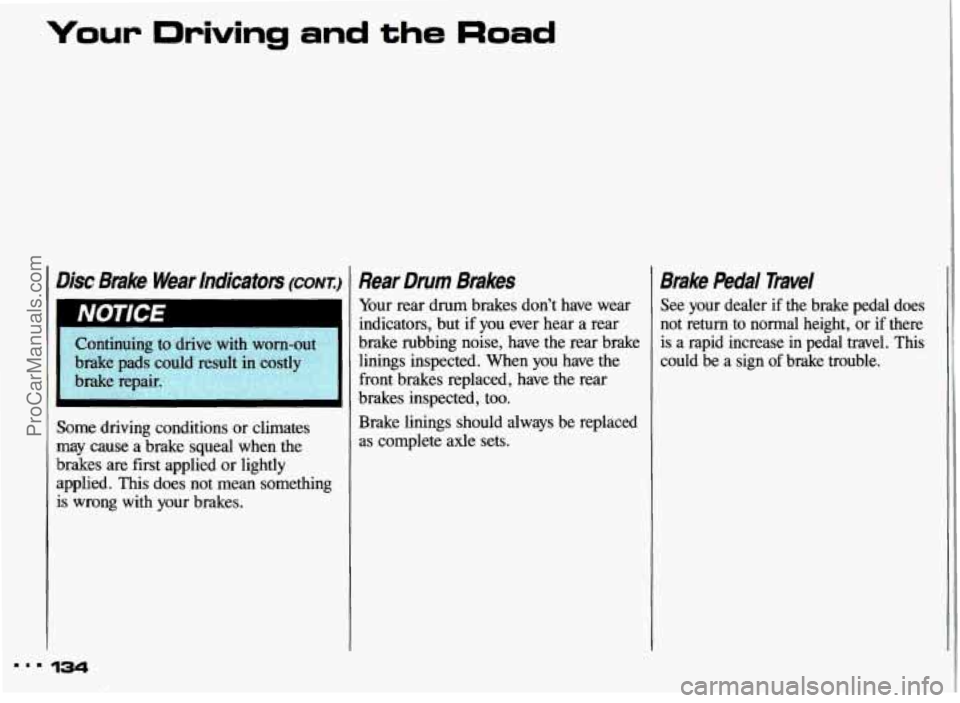
'Your Driving and the Road
Disc Brake Wear Indicators (CONTJ
I
Continuing to drive with worn-out
brake pads could res
: brake repair. P". I
Some driving conditions or climates
may cause a brake squeal when the
brakes are fmt applied or lightly
applied. This does not mean something
is wrong with your brakes.
Rear Drum Brakes
Your rear drum brakes don't have wear
indicators, but if you ever hear a rear
brake rubbing noise, have the rear brake
linings inspected. When you have the
front brakes replaced, have the rear
brakes inspected, too.
Brake linings should always be replaced
as complete axle sets.
Brake Pedal Travel
See your dealer if the brake pedal does
not return to normal height, or if there
is a rapid increase in pedal travel. This
could be
a sign of brake trouble.
ProCarManuals.com
Page 136 of 306

Brake Aflustment
Every time you make a moderate reverse
brake stop, your brakes adjust for wear.
If you rarely make a moderate or
heavier stop, then your brakes might not
adjust correctly. If you drive
in that way,
then-very carefully-make a few
moderate brake stops about every
1,OOO
miles (1 600 km), so your brakes will
adjust properly.
If your brake pedal goes down farther
than
normal, your rear drum brakes may
need adjustment. Adjust them by
backing up and
firmly applying the
brakes a few times.
Braking In Emergencies
Use your anti-lock braking system when
you need to. With anti-lock, you can
steer and brake at the same time. In
many emergencies, steering can help
you more than even the very best
braking.
Power Steering -
If you lose power steering assist because
the engine stops or the system fails to
function, you can steer but it will
take
much more effort.
135
ProCarManuals.com